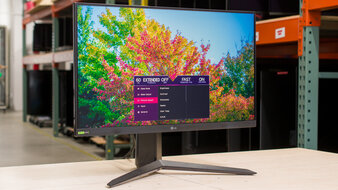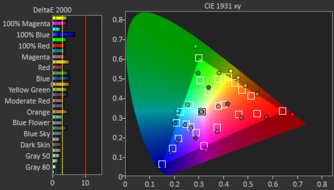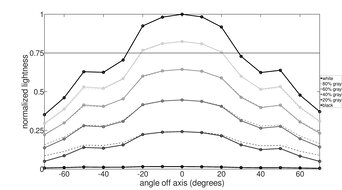Although higher-resolution monitors are the most common resolutions on monitors now, there are still a good number of 1080p displays to choose from. Many have gaming-oriented features, including high refresh rates, which are useful for competitive gaming. While some of these gaming models are also good enough to use for productivity, most don't have office-oriented features, although there are still some cheap models you can get for work. So, you should think about your usage needs before looking for a 1080p monitor.
There are different factors to consider depending on your usage, like if you're a gamer. A fast response time is important so that motion looks sharp, and most monitors have low input lag for a responsive feel and VRR support to reduce screen tearing. Picture quality is another consideration, but many 1080p displays have limited picture quality anyway. Most 1080p monitors are available in a 24- or 25-inch screen size and don't tend to cost a lot, but there are premium esports options that are more expensive.
We've bought and tested over 370 monitors, and below are our recommendations for the best monitors to buy with a 1080p resolution. See our recommendations for the best budget and cheap gaming monitors, the best 24-25 inch monitors, and the best gaming monitors under $300.
Quick Look




We buy and test more than 30 monitors each year, with units that we buy completely on our own, without any cherry-picked units or samples. We put a lot into each unbiased, straight-to-the-point review, and there's a whole process from purchasing to publishing, involving multiple teams and people. We do more than just use the monitor for a week; we use specialized and custom tools to measure various aspects with objective data-based results. We also consider multiple factors before making any recommendations, including the monitor's cost, its performance against the competition, and whether or not it's easy to find.
-
Best 1080p Monitor
 PC Gaming7.2Response Time7.7Office7.4Console Gaming5.7SDR Picture6.3HDR Picture4.7Brightness7.5Size25"Pixel TypeIPSMax Refresh Rate360 HzSee all our test resultsNative Resolution1920 x 1080
PC Gaming7.2Response Time7.7Office7.4Console Gaming5.7SDR Picture6.3HDR Picture4.7Brightness7.5Size25"Pixel TypeIPSMax Refresh Rate360 HzSee all our test resultsNative Resolution1920 x 1080The best 1080p display that we've tested is the Dell Alienware AW2523HF. It's also the best 1080p gaming monitor because of its high 360Hz refresh rate. The high refresh rate is ideal for competitive gaming, and combined with the 1080p resolution, it doesn't require a lot of bandwidth from your graphics card to maintain high frame rates. Motion looks sharp at most refresh rates, but there's more blur at 60Hz. It also supports FreeSync VRR and G-SYNC compatibility to reduce screen tearing.
It's still versatile for other uses besides gaming. It gets bright and handles glare well, so visibility isn't an issue in most well-lit rooms. It also comes with a USB hub that includes four USB-A ports, which are great to use if your computer doesn't have any ports available for other devices. Plus, its excellent ergonomics make it very easy to adjust, ideal if you constantly like to adjust your monitor.
-
Best Budget 1080p Monitor
 PC Gaming7.2Response Time8.1Office7.3Console Gaming5.9SDR Picture6.2HDR Picture4.6Brightness7.5Size24"Pixel TypeIPSMax Refresh Rate240 HzSee all our test resultsNative Resolution1920 x 1080
PC Gaming7.2Response Time8.1Office7.3Console Gaming5.9SDR Picture6.2HDR Picture4.6Brightness7.5Size24"Pixel TypeIPSMax Refresh Rate240 HzSee all our test resultsNative Resolution1920 x 1080While you can get the Dell Alienware AW2523HF for a low cost, if you can't find it on sale at a low cost and you're looking for the best 1080p gaming monitor on a budget, there are a few great options, like the ViewSonic XG2431. The main difference from the Dell is that it has a lower 240Hz refresh rate. This means gaming doesn't feel as smooth, but its refresh rate is still good enough for most gamers. It doesn't get as bright as the Dell, either, so it's worse to use in a bright room.
That said, there are a few advantages to getting this over the Dell. It has better motion handling across its VRR range and a backlight strobing feature to reduce persistence blur, which the Dell doesn't have. You can customize the backlight strobing to fine-tune it to your liking, which is something many monitors can't do, but you can't use it at the same time as VRR.
-
Best Cheap 1080p Monitor
 PC Gaming7.0Response Time7.5Office7.0Console Gaming5.1SDR Picture6.5HDR Picture4.8Brightness7.0Size24"Panel TypeIPSMax Refresh Rate180 HzSee all our test resultsNative Resolution1920 x 1080
PC Gaming7.0Response Time7.5Office7.0Console Gaming5.1SDR Picture6.5HDR Picture4.8Brightness7.0Size24"Panel TypeIPSMax Refresh Rate180 HzSee all our test resultsNative Resolution1920 x 1080Should you want a simple and cheap 1080p gaming monitor, you can find the LG 24GS65F-B for less than the ViewSonic XG2431. The main difference between this and the ViewSonic is that it has a lower 180Hz refresh rate and worse motion handling, with more blur behind fast-moving objects. It doesn't have a backlight strobing feature to reduce persistence blur either, and it lacks a few features the ViewSonic has, like a small USB hub, which is the trade-off for getting something cheaper.
That said, it still has gaming features, like virtual crosshairs and support for common VRR formats to reduce screen tearing with gaming PCs. Besides that, it's well-built for a cheap monitor and comes with an ergonomic stand, so it's easy to adjust to your favorite position. Its matte screen coating also reduces glare well, but it doesn't get bright enough to fight intense glare. Although this monitor doesn't have work-oriented features, if you want a cheap 1080p monitor that does, check out the Dell P2425H. However, it's a more basic display without any gaming features like the LG.
Notable Mentions
-
LG 32GS95UE-B:
The LG 32GS95UE-B is a premium gaming monitor that technically isn't a 1080p monitor because it has a native 4k resolution, but it has a Dual-Mode feature that changes it to a 1080p, 480Hz display. It's worth getting over the Dell Alienware AW2523HF if you want premium picture quality, as it has an OLED panel, but 1080p content is less sharp than on a native 1080p display, like the Dell.
See our review -
BenQ ZOWIE XL2586X:
The BenQ ZOWIE XL2586X is an esports gaming monitor with a higher 540Hz refresh rate than the Dell Alienware AW2523HF. It's something to consider if you want such a high refresh rate with smooth motion, but it also costs a lot more than the Dell and has worse picture quality.
See our review -
Dell G2524H:
The Dell G2524H is a cheap gaming monitor with a higher 280Hz refresh rate than the LG 24GS65F-B. This makes the Dell a great choice if you want the higher refresh rate for competitive gaming, but it costs more and can be harder to find than the LG.
See our review
Recent Updates
Oct 10, 2025:
We replaced the Dell G2524H with the LG 24GS65F-B, which is easier to find. We also removed the Dell P2425H, as it doesn't fit into the article's scope. In the Notable Mentions, we removed the AOC 24G15N and added the G2524H.
Jun 09, 2025:
We updated the text for accuracy throughout and verified that the recommendations are still valid.
Mar 14, 2025:
We replaced the ASUS ROG Swift Pro PG248QP with the Dell Alienware AW2523HF for consistency with other recommendations and because the ASUS is harder to find. We added the Dell G2425H as the 'Best Cheap' monitor because it offers good value and renamed the Dell P2425H the 'Best 1080p Work Monitor.' We also added the AOC 24G15N to the Notable Mentions.
Feb 19, 2025:
We removed the ASUS TUF Gaming VG249Q1A, as it's an older monitor. We also replaced the AOC 24G15N with the Dell P2425H because the AOC is hard to find. Lastly, we introduced a new format to the article and updated the text to reflect these changes.
Nov 21, 2024:
We replaced the Dell Alienware AW2523HF with the ASUS ROG Swift Pro PG248QP, which has a higher refresh rate. We also replaced the Dell P2425H with the AOC 24G15N in the cheap category because the AOC has more gaming features. In the Notable Mentions, we removed the ASUS VG246H, which is hard to find, and added the P2425H, LG 32GS95UE-B, and the BenQ ZOWIE XL2586X.
All Reviews
Our recommendations are based on what we think are the best monitors with a native resolution of 1080p that are currently available, including the best 1080p gaming monitors. They're adapted to be valid for most people in each price range. Our rating is based on our review, factoring in price and feedback from our visitors.
If you'd prefer to make your own decision, here's the list of all of our 1080p monitor reviews. Be careful not to get too caught up in the details. Most monitors are good enough to please most people, and the things we fault monitors on are often not noticeable unless you really look for them.









